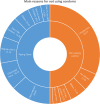HIV prevention and treatment cascades among female sex workers in Ghana: gaps and priorities that should be addressed by the national programme
- PMID: 39695428
- PMCID: PMC11654140
- DOI: 10.1186/s12879-024-10322-2
HIV prevention and treatment cascades among female sex workers in Ghana: gaps and priorities that should be addressed by the national programme
Abstract
Background: There is currently limited knowledge about HIV prevention and treatment cascades among female sex workers (FSW) in Ghana. This study sought to use the 2020 bio-behavioural survey (BBS) among FSWs to identify gaps and priorities in HIV treatment and prevention cascades to help achieve the 95-95-95 fast track targets.
Method: The study used a cross-sectional design with Time Location Sampling (TLS) technique in all regions of Ghana. All eligible FSW at the selected venues and stipulated time frame were interviewed and tested for HIV onsite using the national testing algorithm. For condom use and HIV testing cascades, each step of the cascade was calculated as a percentage of all FSW. Analysis of treatment cascade was restricted to HIV positive participants and was presented using both conditional (% eligible PLHIV) and unconditional (% all PLHIV) approaches. Viral suppression level was defined as < 1000 copies/ml.
Results: A total of 6,773 participants took part in the behavioral interviews while 6,217 took part in the biological component which involves HIV testing. In all, 33% and 80% of all FSW do not consistently use condoms with their paying clients and non-paying partners respectively. The findings further show that 26.6% of FSW have never tested for HIV, and contrary to the HIV testing policy of every six months for FSW, 70.0% did not test for HIV 6 months preceding the survey and 40.7% of all FSW did not test for HIV 12 months preceding the survey. The conditional treatment cascade was 32%-71%-57% while the unconditional cascade was 32%-23%-49%. The study further shows 68% of the HIV positive FSW were not aware of their HIV positive status, 77% were not on treatment, while nearly 51% were not virally suppressed regardless of treatment status.
Conclusion: The results show that both the prevention and treatment cascades are suboptimal. Key gaps identified include low: HIV testing, viral load suppression, condom use with both paying clients and non-paying partners. There is therefore the need to scale prevention and treatment interventions particularly HIV testing, treatment initiation, consistent condoms use with both paying clients and non-paying partners to help achieve the 95-95-95 fast track targets.
Keywords: Female sex workers; Ghana; HIV; Prevention cascade; Treatment cascade.
© 2024. The Author(s).
Conflict of interest statement
Declarations. Ethics approval and consent to participate: This study received ethical approval from the University of Ghana Noguchi Memorial Institute of Medical Research Institutional Review Board (CPN 083/18–19), the Ghana Health Service Ethical Review Committee (GHS-ERC 002/05/19) and the Population Council Institutional Review Board (Protocol 891), New York, USA. Study participation was voluntary, and respondents were informed that they were free to withdraw from the study at any time during the survey process. Following careful explanation of the survey, study staff gave eligible respondents the consent form to read or, if necessary, had the consent form read to the respondents by a staff member. All respondents signed that they understood and agreed to all the items contained in the consent form before being enrolled in the survey. Consent for publication: Not applicable. Competing interests: The authors declare no competing interests.
Figures








References
-
- CDC. US Public Health Service: Preexposure prophylaxis for the prevention of HIV infection in the United States – 2021 update, a clinical practice guideline. 2021
MeSH terms
LinkOut - more resources
Full Text Sources
Medical

